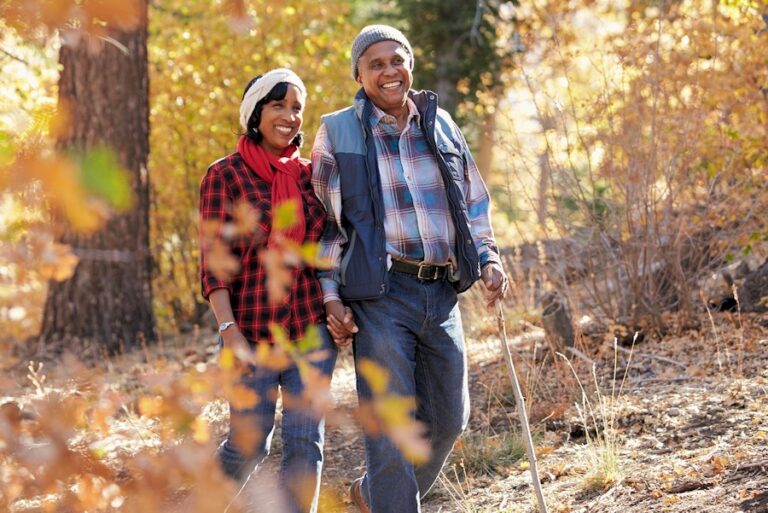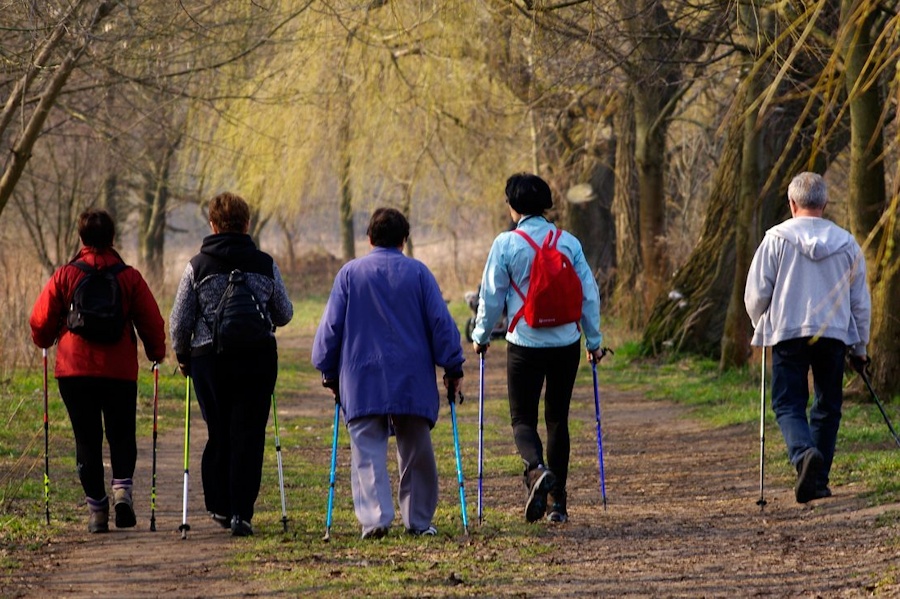
Hiking in “Seasoned” Years
Plenty of scientific evidence supports the fact that regular exercise helps us stay healthy, mobile, and independent into our “seasoned” years. In fact, studies have shown that daily moderate exercise can mean the difference between becoming inactive and perhaps housebound at an early age or being able to remain active and keep up with everyday activities.
Beginning a new exercise regime can offer a new source of fun, as well as some tremendous health benefits. Of course, the activity must be appropriate to our abilities and health status. One enjoyable way to incorporate exercise into your life is to take up hiking. Do not be intimated by the word. Hiking does not mean traversing dangerous trails up mountains and through dense forests. Hiking is really just a process of walking outdoors in nature. If you can walk, you can hike.
One of the great things about hiking is that it’s a form of exercise you can do at your own pace and in an environment of your own choosing. Going on a hike can mean simply taking a leisurely walk along a well-defined, well- maintained path next to a flowering meadow or along a bubbling brook. While hiking provides exercise, you can also incorporate other activities into your adventure… like bird watching, looking for wildlife, and identifying different types of vegetation.
Hiking can be a social endeavor as well. Hiking with friends and family can be lots of fun. Plus, there are many hiking clubs tailored to those of us in our “seasoned” years. Club members hike in groups. Novice hikers set out together for shorter distances on trails appropriate to their abilities, while hikers with more experience tackle trails that are a bit more challenging.
If you’re interested in hiking, make sure to discuss your plans with your doctor before heading out on your first trail. It’s important to get your doctor’s approval before beginning any new form of exercise. Even those people who may have been avid hikers in early adulthood may need to make some kind of adjustments in their hiking routine as they head into later life.
The following tips provide some of the information you need to hike safely.
Helpful tips if you’re new to hiking…
- Plan your hikes according to your fitness level and personal abilities. Make sure to research trails well so you can select those that are best for you. If you have any balance or mobility issues, look for hiking trails that are flat and easy to negotiate.
- Use a walking stick or trekking poles. If you have physical, balance, or mobility problems, it is important to use a walking stick or other walking aid. Assistive devices can make your hike easier and more fun, especially in hilly or uneven terrain. You doctor will be able to tell you if you should be using an assistive device and recommend the type of device to best meet your needs.
- Hike at your own pace. A hike is not a race. Do not push yourself beyond your own fitness, endurance, and stamina levels. Make sure to stop for frequent breaks along your route so you can relax, recharge you batteries, rest your feet, drink some fluids, eat a snack, and enjoy the scenic surroundings.
- Avoid hiking when it’s hot or humidity is high. Begin your hike in the morning during warmer months. Mornings are always cooler and you can get off the trail and back home before the hottest time of day. A late afternoon hike can also be comfortable temperature-wise, but make sure you will be able to get back before dusk.
- Always check the weather forecast. Before heading out on a hike, it is vital to know what to expect from the elements. You don’t want to be caught by surprise by an unanticipated shift in the weather.
- Never hike alone. It’s always safest to hike with at least two people. An emergency can happen when you least expect it. You don’t want to be alone in a dangerous situation.
- Always let someone know you are going on a hike. Tell the person the time period when you will be hiking, the location where you will be hiking, and when you expect to return home.
- Stretch your muscles before heading out on a hike. It’s always necessary to loosen up your body prior to beginning a hike to avoid cramping and/or injury.
- Dress in layers. You will want to be able to add or remove pieces of clothing as needed during your hike. The temperature can change dramatically during a hike, especially if you will be walking on a trail with different elevations. It’s a good idea to have a lightweight jacket with you as well and to be prepared for inclement weather.
- Wear comfortable walking shoes. Shoes or sneakers should be lightweight, offer support, and have nonskid soles. Always break in your shoes before wearing them out on a hike. New shoes can cause blisters and other painful issues. Bring an extra pair of socks along too. You will want your feet to be comfortable, warm, and dry throughout your hike.
- Carry a backpack. You will want to have some essentials with you that you may not want to carry in your pockets or hands. There are many small, lightweight backpacks available that are easy for anyone to put on and wear. Your hiking buddy can always help you get to whatever you have in your backpack if you have difficulty doing so yourself. See our suggestions below about items to bring along in your backpack.
Important items to bring with you…
Experienced hikers recommend carrying the following items in your backpack whenever you head out on a hiking trail.
- Water and/or sports drinks. It’s very easy to become dehydrated quickly while hiking, especially on a warm day. According to the National Park Service (NPS), packing enough water and food is one of the most important things to do when preparing for a hike. The NPS recommends drinking ½ to 1 quart (liter) of water or sports drink every hour of hiking.
- Healthy snacks. You will want to keep your energy up while hiking. There are plenty of easy-to-carry food items available that are filled with the calories, protein, and other nutrients you need to keep your body healthy and moving, like trail mix, energy bars, jerky, dried fruit, nuts, and even chocolate. The National Park Services recommends that all hikers snack regularly. Eat before you feel hungry and drink before you’re thirsty.
- A trail map or guide and a compass. Make sure your map or guide is current and includes all the geographic features and landmarks in the area. Do not depend on your cell phone to provide a map or necessary information. Cell phones may not work in isolated hiking areas.
- A safety whistle and signal mirror. Nobody expects to need a way to signal for help, but it happens. Make sure you are prepared… just in case.
- A small first-aid kit. Cuts and scrapes are common byproducts of hiking. You’ll be glad you have a first-aid kit with you, even if it is just to have a Band-Aid ® on hand to cover a minor blister.
- Sun protection. Even if your hike is along a shady trail, you’ll be exposed to the sun’s rays. Always bring along sunscreen and lip balm, and reapply them regularly. Also wear sunglasses and a lightweight hat to protect your eyes, head, and face.
- Any medications you may need. If there are daily medications you should take during the time frame of your hike, bring them with you. You don’t have to take along the entire bottle. Put the pills you will need in a small travel medication case or a plastic food storage bag.
- Insect repellent. There are a myriad of flying and crawling bugs residing in most hiking areas. You won’t want to be up close and personal with any of them. Spray yourself with a DEET-based insect repellent before you step out on a hiking path and reapply as directed. It is especially important to avoid contact with ticks, because they can carry Lyme disease. You and your hiking partner(s) should check each other regularly for ticks.


Age Adds Flavor
We are not old, we are seasoned!
Don’t forget to visit us on FACEBOOK!
